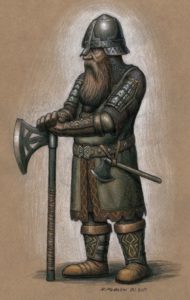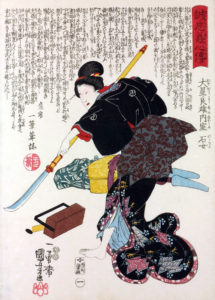 The works of J.R.R. Tolkien have codified the nature of high fantasy ever since their inception. So iconic is the world on Middle Earth that fantasy authors often have to make a point of altering Tolkien’s mold. And in no aspect of the Tolkienian mythos is this fact more prominent, than with Dwarves. Dvergar. Svartalvar. Those gruff little bearded violence monkeys who populate the mountain mines of every high fantasy world in your local bookshop.
The works of J.R.R. Tolkien have codified the nature of high fantasy ever since their inception. So iconic is the world on Middle Earth that fantasy authors often have to make a point of altering Tolkien’s mold. And in no aspect of the Tolkienian mythos is this fact more prominent, than with Dwarves. Dvergar. Svartalvar. Those gruff little bearded violence monkeys who populate the mountain mines of every high fantasy world in your local bookshop.
Dwarves, more than any other mythic creature, are largely homogenous along works. Four or five feet tall, heavily bearded (across gender lines), metal-working, gold-hoarding, mead-drinking, axe and hammer wielding Scottish stereotypes. So alike are the dwarves of various works, that in a series of TV Tropes articles titled “Our [Mythical Creature]s Are Different” about different writers’ variations on various monsters, the one on Dwarves is called “Our Dwarves Are All The Same.”
And I’m not saying there’s anything wrong with that. If the mold for Dwarves ain’t broke don’t fix it. But there is a logical flaw in the design. Namely, the obsession with Battle Axes and Mauls. The intention of giving dwarves these weapons is to draw a connection to the Vikings (though the maul was first employed as a weapon in 14th century France), and to convey the idea that the dwarves value strength and physical force. But setting aside the issue of why a race with no desire or need to chop wood would develop an axe to repurpose as a weapon in the first place, the real problem has to do with the fact that these weapons are usually depicted as short-handled (which is to say, closer to the length of a mace than to a pole arm, i.e. not taller than the dwarf himself). And to explain why, I’m going to talk about medieval Japanese women now.
 The Onna-Bugeisha were more or less female members of the Samurai class in feudal Japan. Often the wives of male Samurai and trained to defend the home in times of war, the Onna-Bugeisha were a prominent class of warrior for much of Japanese history. (I based a webcomic superhero on the archetype because it’s awesome.) Rather than the katana used universal by male samurai, the iconic weapon of the Onna-Bugeisha was the naginata, a pole weapon which is essentially a katana blade at the end of a stick about the height of the wielder (see the image). This was the weapon of choice for female warriors specifically because the greater reach and leverage it provided compensated for the superior size and physical strength of male opponents. It’s not exactly hard to imagine the benefits: a well-trained woman with a pole arm can kill a man with a sword before he gets close enough to injure her horse. These warriors recognized their physical limitations and chose a weapon that offset that. Dwarves have done no such thing.
The Onna-Bugeisha were more or less female members of the Samurai class in feudal Japan. Often the wives of male Samurai and trained to defend the home in times of war, the Onna-Bugeisha were a prominent class of warrior for much of Japanese history. (I based a webcomic superhero on the archetype because it’s awesome.) Rather than the katana used universal by male samurai, the iconic weapon of the Onna-Bugeisha was the naginata, a pole weapon which is essentially a katana blade at the end of a stick about the height of the wielder (see the image). This was the weapon of choice for female warriors specifically because the greater reach and leverage it provided compensated for the superior size and physical strength of male opponents. It’s not exactly hard to imagine the benefits: a well-trained woman with a pole arm can kill a man with a sword before he gets close enough to injure her horse. These warriors recognized their physical limitations and chose a weapon that offset that. Dwarves have done no such thing.
Physical strength probably isn’t a problem for the stockily-built Dwarf. Reach, however, definitely is. Dwarves are generally depicted as just over half the size of humans, elves and other races (if that) out-tinied only by cute little rural-English halflings/gnomes/hobitses. When you’re fighting an opponent who’s arms are twice as long as yours, every inch of weapon on your side counts. The dwarf might be on even ground in terms of strength, and definitely has the benefit of a lower center of gravity, but in this case, length does matter.
But let’s say fantasy writers don’t take my advice, and continue to give dwarves overweighted forestry tools instead of a proper spear. Let’s take a look at what a fight might realistically look like:
Say you have a stereotypically Tolkienian Dwarf and Elf about to engage in deadly single combat. The Dwarf has an Axe, about the length of his arm. The Elf has a sword, a three for long leaf shaped razor-sharp blade that alerts darkness-dwelling murder monsters to its presence by glowing brightly whenever they’re nearby. They stand at opposite ends of a forest clearing, weapons at the ready.
Abruptly, the dwarf charges at his opponent, screaming bloody viking murder, rearing back his axe so that he can put all his strength into the swing when that time comes because fantasy writers have no idea that weapons aren’t supposed to weigh more than 5 to 10 pounds. (see #60)
The elf does nothing.
The dwarf continues to run. He’s not very fast; his legs are short and he tends to lug around a rather cumbersome amount of weight with him.
As the dwarf nears his opponent, the Elf waits until just before the last possible second, then, with his supernaturally elven reflexes, lifts his sword arm to a roughly 60° angle to the rest of his body.
The dwarf, unable to stop due to the inertia of the sixty-odd pounds of battle-axe, outlandishly thick plate armor, gold-coins, and beard that he lugs around with him at all times, and unable to parry due to the fact that the axe represents about 15 or 20 of those pounds, runs into his opponent’s weapon and is impaled in the throat without getting within a foot of axe-swinging range.
Meanwhile across the enchanted forest a dwarf who bothered to learn how to use a spear in the event that he had to fight a taller opponent is getting some actual fencing done. Good on him.
